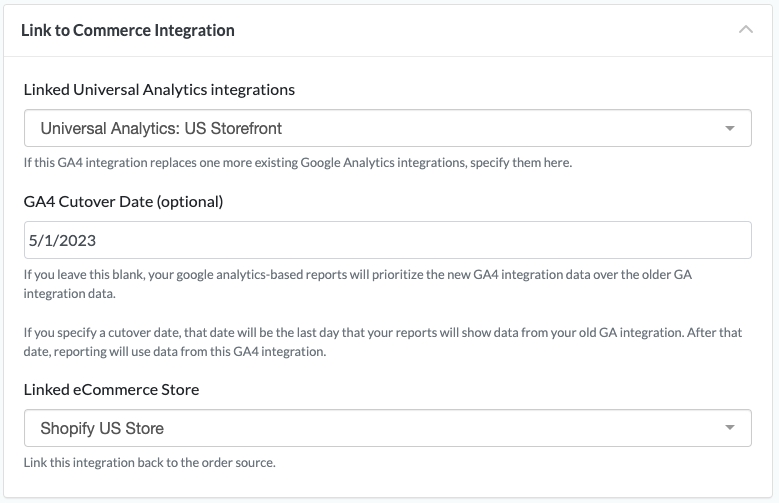Blending Universal Analytics & GA4 Data
Introduction to the Universal Traffic Schema (UTS)
We developed the universal traffic schema (UTS) as a data model to blend your Universal Analytics (UA) and Google Analytics 4 data together so that you won't have switch back and forth between separate UA and GA4 reports for your website analyses.
We created UTS models for traffic, product performance, shopping funnel, and transactions data.
Data blending
When you set up a GA4 integration, you have the option to link it to an ecommerce store and specify which UA integration the data should blend with. This is essentially telling Daasity which old UA integration the new GA4 integration will be taking over for:

The GA4 Cutover Date (see example above) allows you to specify when the GA4 integration should pick up where your UA integration left off in your reporting. If you've been using GA4 for a while and trust it, you can put an early date like 2/1/2023. If you're trying to squeeze every last drop from UA, you can input the last day your UA property tracked new data. If you don't specify a cutover date, our code will default to 7/1/2023.
With this setup, your UA and GA4 data will blend nicely without any overlap, even though you may have overlapping data stored in the raw UA and GA4 tables.
For example, if you have a cutover date of 5/1, the unsegmented data in your Traffic explore will show one continuous stream of data:
But if you pivot by the Data Source Version dimension, you'll see that this data is actually a blend of UA and GA4 data. The last day of UA data is from 4/30, and the first day of GA4 data is from 5/1:
Where to find UTS data
UTS powers our Traffic, Product Page, and Shopping Stage explores, and is also used for Google Analytics-based attribution models. That means all GA-based attribution after your cutover date will use GA4 data, and all attribution before the cutover date will use UA data.
UTS data is also fed into downstream reports like the daily and weekly flash reports and company metrics reports. The sessions metrics in those reports will reflect blended UA and GA4 data.
Differences between UA and GA4 data
Even though we're blending UA and GA4 data into a normalized schema, it doesn't mean that the underlying data will be exactly apples to apples. There are important differences to understand between the UA and GA4 data models. The following articles will help explain some of the most important differences:
Was this helpful?